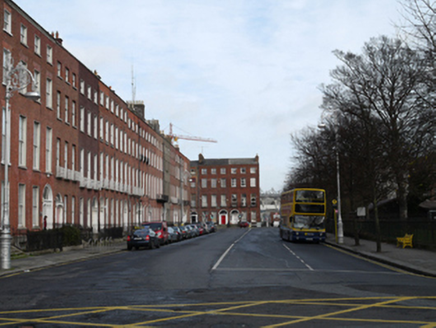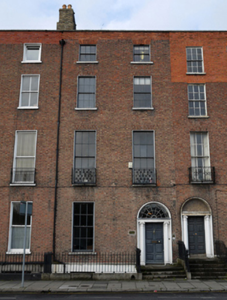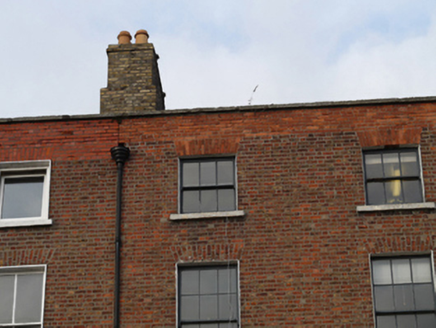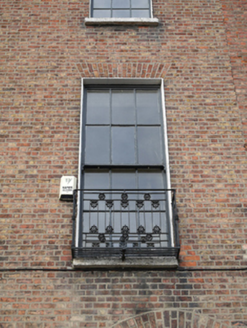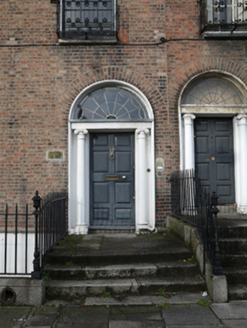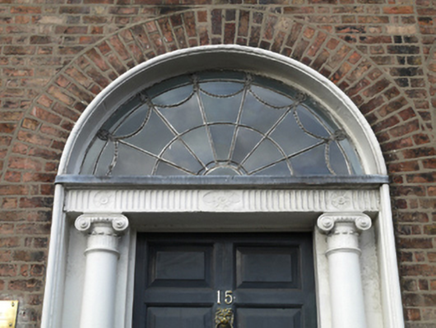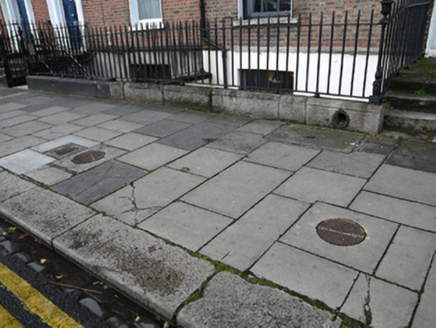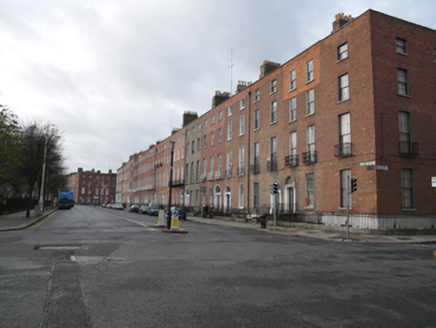Survey Data
Reg No
50010808
Rating
Regional
Categories of Special Interest
Architectural, Artistic
Original Use
House
In Use As
Office
Date
1790 - 1795
Coordinates
316061, 235546
Date Recorded
08/12/2011
Date Updated
--/--/--
Description
Terraced two-bay four-storey house over raised basement, built c.1792, having four-storey return to rear (north) elevation. Now in use as offices. Double-pile slate roof, pitched to front (south) elevation, with two hipped projections set perpendicular to rear. Shared brown brick chimneystack having clay pots to west party wall, hidden behind rebuilt red brick parapet wall with granite coping. Cast-iron rainwater goods having round hopper to west of façade. Red brick walls laid in Flemish bond with flush pointing to granite plinth course over painted rendered wall to basement. Rendered wall to rear. Gauged brick flat-arched window openings having patent rendered reveals, granite sills and replacement timber sliding sash windows, three-over-three pane to top floor, six-over-six pane to lower floors, and eight-over-eight pane to basement. Cast-iron balconettes to first floor windows, steel grilles to basement windows. Flat-arched window openings to rear with flush reveals, granite sills and replacement timber sliding sash windows, three-over-three pane to top floor and six-over-six pane to lower floors. Casement windows to return. Gauged brick round-arched door opening having moulded masonry surround and painted stone Ionic doorcase, with original raised-and-fielded timber panelled door flanked by engaged Ionic columns supporting fluted lintel cornice, with elaborate cobweb fanlight. Door opens onto granite platform with four granite steps bridging basement. Platform and basement enclosed by original wrought-iron railings and cast-iron corner posts set on moulded granite plinth wall to street. Recent metal door under entrance platform. Cast-iron coal hole covers to pavement to front.
Appraisal
This house is unusual among others on the terrace in being only two bays wide. It retains much of its original form and character, with a fine doorcase and original raised-and-fielded panel door adding architectural interest. Cast-iron balconettes add subtle decorative interest. The unrendered stone plinth and the railings to the basement area enhance the setting. It greatly contributes to this important urban landscape. Mountjoy Square was built on lands formerly belonging to Saint Mary’s Abbey and laid out in 1790 by Luke Gardiner II, completed by 1818. Originally called Gardiner Square, it was planned to develop a strong vista from Custom House to Mountjoy Square and thence to the planned Royal Circus. Unlike other Georgian squares in the city, this example was more carefully laid out with a unified parapet height and the east-west approaches offset to create a sense of enclosure. After falling into serious neglect and dereliction throughout the twentieth century resulting in the loss of one third of its original buildings, the square has since been repaired.
